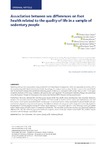Mostrar o rexistro simple do ítem
Association between sex differences on foot health related to the quality of life in a sample of sedentary people
| dc.contributor.author | López-López, Daniel | |
| dc.contributor.author | Cancela Carral, Xosé María | |
| dc.contributor.author | Araujo, Romeu | |
| dc.contributor.author | Losa Iglesias, Marta Elena | |
| dc.contributor.author | Becerro-de-Bengoa-Vallejo, Ricardo | |
| dc.contributor.author | Rodríguez-Sanz, David | |
| dc.contributor.author | Calvo-Lobo, César | |
| dc.date.accessioned | 2022-02-09T10:45:47Z | |
| dc.date.available | 2022-02-09T10:45:47Z | |
| dc.date.issued | 2019-02 | |
| dc.identifier.citation | López-López, Daniel et al. Association between sex differences on foot health related to the quality of life in a sample of sedentary people. Revista da Associação Médica Brasileira [online]. 2019, v. 65, n. 2 [Accessed 9 February 2022] , pp. 149-155. Available from: <https://doi.org/10.1590/1806-9282.65.2.149>. ISSN 1806-9282. https://doi.org/10.1590/1806-9282.65.2.149. | es_ES |
| dc.identifier.issn | 1806-9282. | |
| dc.identifier.uri | http://hdl.handle.net/2183/29743 | |
| dc.description.abstract | [Abstract] Sedentary (sitting) time may produce many anatomical and physiological consequences which are supposedly associated with a decreased quality of life (QoL) related to foot health. Accordingly, this study aimed to analyze the QoL impact on the overall health and the foot health among male and female sedentary people. A total of 312 participants with an age mean of 39.81 ± 15.40 years completed all phases of the study. In addition, self-reported data were registered. The participants' sedentary lifestyle was determined using the European Prospective Investigation into Cancer and Nutrition (EPIC) physical activity questionnaire. Furthermore, the scores obtained from the Portuguese version of the Foot Health Status Questionnaire were registered. Sedentary people in the equivalent metabolic energy had 301.09 ± 72.22 (min/week). In the first section, values were higher for foot pain and foot function and lower for general foot health and footwear. In the second section, values were higher for general health and vigor and lower for physical activity and social capacity. The differences between the sex groups of the study were statistically significant for footwear (P = 0.008), physical activity (P= 0.002), social capacity (P = 0.001) and vigor (P = 0.001) showing a worst QoL related to foot health in favor of male subjects in comparison with females. The rest of the domains did not show any statistically significant difference (P ≥ .01). The sedentary population evidenced a negative impact on the QoL related to foot health. This problem may be associated with this lifestyle, especially for males. | es_ES |
| dc.description.abstract | [Resumo] O tempo sedentário (sentado) pode produzir muitas consequências anatômicas e fisiológicas que supostamente estão associadas a uma redução de qualidade de vida (QoL) relacionada à saúde do pé. Por conseguinte, o objetivo deste estudo foi analisar o impacto da QV sobre a saúde geral e a saúde do pé entre pessoas sedentárias masculinas e femininas. Uma amostra de 312 participantes com idade média de 39,81 ± 15,40 anos completou todas as fases do processo de estudo. Além disso, os dados autorrelatados foram registrados. O comportamento sedentário dos informantes foi determinado usando o questionário de prospecção prospectiva de câncer e nutrição (Epic). Além disso, os resultados obtidos com a versão em português do Questionário de Status de Saúde do Pé (PFHSQ) foram registrados. As pessoas sedentárias no equivalente de energia metabólica apresentaram 301,09 ± 72,22 (min/semana). Na primeira seção, os valores foram maiores para a dor no pé e função do pé e diminuíram a saúde e o calçado do pé geral. Na segunda seção, os valores foram maiores para saúde geral e vigor e menores para atividade física e capacidade social. As diferenças entre os grupos sexuais do estudo foram estatisticamente significativas para o calçado (P = 0,008), atividade física (P = 0,002), capacidade social (P = 0,001) e vigor (P = 0,001), mostrando uma pior QV relacionada à saúde do pé a favor dos sujeitos do sexo masculino em relação aos participantes sedentários femininos. O restante dos domínios não apresentou diferença estatisticamente significante (P ≥ 0,01). A população sedentária evidenciou um impacto negativo na QoL relacionada à saúde dos pés. Esse problema pode estar associado a este comportamento, especialmente no sexo masculino. | es_ES |
| dc.language.iso | eng | es_ES |
| dc.publisher | AMB | es_ES |
| dc.relation.uri | https://doi.org/10.1590/1806-9282.65.2.149 | es_ES |
| dc.rights | Atribución-NoComercial 3.0 España | es_ES |
| dc.rights.uri | http://creativecommons.org/licenses/by-nc/3.0/es/ | * |
| dc.subject | Foot | es_ES |
| dc.subject | Foot deformities | es_ES |
| dc.subject | Foot injuries | es_ES |
| dc.subject | Quality of life | es_ES |
| dc.subject | Sedentary lifestyle | es_ES |
| dc.subject | Sedentarismo | es_ES |
| dc.subject | Pie | es_ES |
| dc.subject | Deformidades del pie | es_ES |
| dc.subject | Lesiones en el pie | es_ES |
| dc.subject | Calidad de vida | es_ES |
| dc.title | Association between sex differences on foot health related to the quality of life in a sample of sedentary people | es_ES |
| dc.type | info:eu-repo/semantics/article | es_ES |
| dc.rights.access | info:eu-repo/semantics/openAccess | es_ES |
| UDC.journalTitle | Revista da Associaçao Médica Brasileira | es_ES |
| UDC.volume | 65 | es_ES |
| UDC.issue | 2 | es_ES |
| UDC.startPage | 149 | es_ES |
| UDC.endPage | 155 | es_ES |
Ficheiros no ítem
Este ítem aparece na(s) seguinte(s) colección(s)
-
GI-UDISAP - Artigos [196]






